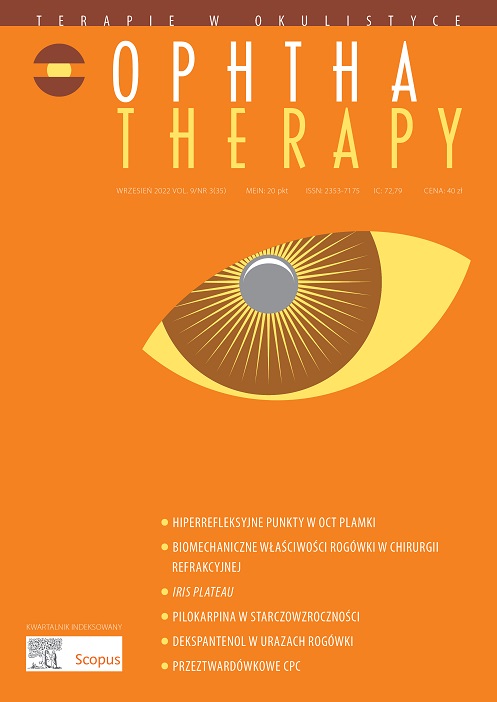Dekspantenol w leczeniu schorzeń i urazów rogówki Artykuł przeglądowy
##plugins.themes.bootstrap3.article.main##
Abstrakt
Dekspantenol – prekursor witaminy B5 – jest związkiem pochodzenia naturalnego, który ma znany od dawna dobroczynny wpływ na nawilżenie skóry i błon śluzowych oraz na gojenie się nabłonków. W leczeniu wykorzystuje się również jego aktywność przeciwzapalną. Wpływ dekspantenolu na tkanki powierzchowne był obserwowany w licznych badaniach in vitro i in vivo, jednak dokładny mechanizm działania nie został do tej pory poznany. W okulistyce dekspantenol jest znanym i szeroko stosowanym lekiem u pacjentów z ostrymi i przewlekłymi chorobami powierzchni oka oraz następstwami urazów rogówki.
Pobrania
##plugins.themes.bootstrap3.article.details##
Copyright: © Medical Education sp. z o.o. License allowing third parties to copy and redistribute the material in any medium or format and to remix, transform, and build upon the material, provided the original work is properly cited and states its license.
Address reprint requests to: Medical Education, Marcin Kuźma (marcin.kuzma@mededu.pl)
Bibliografia
2. Hamdi IM. Effect of D-Panthenol on Corneal Epithelial Healing after Surface Laser Ablation. J Ophthalmol. 2018; 2018: 6537413.
3. Nagar A, Jain S, Singh S. Brief Communication: Dexpanthenol and Its Ophthalmic Uses. J Clin Exp Ophthalmol. 2017; 8: 5.
4. Cho YS, Kim HO, Woo SM et al. Use of Dexpanthenol for Atopic Dermatitis – Benefits and Recommendations Based on Current Evidence. J Clin Med. 2022; 11(14): 3943.
5. Novelli GD. Metabolic functions of pantothenic acid. Physiol Rev. 1953; 33(4): 525-43.
6. Proksch E, de Bony R, Trapp S et al. Topical use of dexpanthenol: a 70th anniversary article. J Dermatolog Treat. 2017; 28(8): 766-73.
7. Forouzesh A, Forouzesh F, Samadi Foroushani S et al. A new method for calculating pantothenic acid content and determining appropriate pantothenic acid levels in foods. SSRN 2022: 4133416.
8. Ebner F, Heller A, Rippke F et al. Topical use of dexpanthenol in skin disorders. Am J Clin Dermatol. 2002; 3(6): 427-33.
9. Wiederholt T, Heise R, Skazik C et al. Calcium pantothenate modulates gene expression in proliferating human dermal fibroblasts. Exp Dermatol. 2009; 18: 969-78. http://doi.org/10.1111/j.1600-0625.2009.00884.x.
10. Gehring W, Gloor M. Effect of topically applied dexpanthenol on epidermal barrier function and stratum corneum hydration: Results of a human in vivo. Arzneimittel-Forschung. 2000; 50: 659-63.
11. Biro K, Thaçi D, Ochsendorf FR et al. Efficacy of dexpanthenol in skin protection against irritation: a double-blind, placebo-controlled study. Contact Dermatitis. 2003; 49(2): 80-4.
12. Abdelatif M, Yakoot M, Etmaan M. Safety and efficacy of a new honey ointment on diabetic foot ulcers: a prospective pilot study. J Wound Care. 2008; 17(3): 108-10.
13. Brzheskiy VV, Popov VY, Kalinina NM et al. [Prevention and treatment of degenerative changes in ocular surface epithelium in patients with dry eye syndrome]. Vestn Oftalmol. 2018; 134(5): 126-34.
14. Raczyńska K, Iwaszkiewicz-Bilikiewicz B, Stozkowska W et al. [Clinical evaluation of provitamin B5 drops and gel for postoperative treatment of corneal and conjuctival injuries]. Klin Oczna. 2003; 105(3-4): 175-8.
15. Egorov EA, Kalinin NI, Kiiasov AP. [New stimulants of corneal reparative regeneration]. Vestn Oftalmol. 1999; 115(6): 13-5.
16. Rüther L, Voss W. Hydrogel or ointment? Comparison of five different galenics regarding tissue breathability and transepidermal water loss. Heliyon. 2021; 7(1): e06071.
17. Dekspantenol. Opis.

